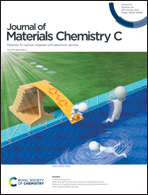Dual-phase zinc selenide in situ encapsulated into size-reduced ZIF-8 derived selenium and nitrogen co-doped porous carbon for efficient triiodide reduction reaction†
Abstract
Constructing cost-effective and robust counter electrodes (CEs) without noble metals remains a challenge for the commercialization of current dye-sensitized solar cells (DSSCs). In this study, we focus on the built-in zinc element into the zeolitic imidazolate framework (ZIF-8) to construct a composite of dual-phase zinc selenide (ZnSe) encapsulated by the size-reduced ZIF-derived Se/N-doped carbon (PS N-CSR) using a post-selenization procedure. Benefitting from the enhanced synergy and charge transfer between the small-sized doped carbon skeleton and well-dispersed dual-phase ZnSe active sites, the resultant PS N-CSR exhibited superior catalytic activity and durability to the triiodide reduction reaction (IRR). The devices that utilize PS N-CSR CE achieved a high power conversion efficiency of 8.48%, surpassing that of Pt (7.20%). It is expected that this work will provide an extensible pathway for designing efficient hybrid electrocatalysts with beneficial structures containing transition metal compounds based on ZIF analogs.



 Please wait while we load your content...
Please wait while we load your content...